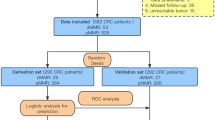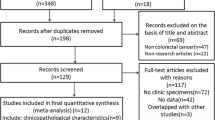Abstract
Purpose
Fanconi anemia protein, FANCJ, directly interacts with MLH1, a key protein involved in DNA mismatch repair. Deficient mismatch repair, or microsatellite instability, is a potent marker for the ineffectiveness of 5-fluorouracil (5-FU) in colorectal cancer (CRC). We investigated the significance of FANCJ expression in CRC, focusing on the effects of 5-FU-based adjuvant chemotherapy.
Methods
Clinicopathologic features and immunohistochemical expression of FANCJ and MLH1 were studied in 219 patients with CRC. We also analyzed 5-FU sensitivity in CRC cell lines with varying levels of FANCJ expression.
Results
FANCJ expression was elevated in tumor tissues compared with normal epithelial tissue. High expression of FANCJ was significantly associated with 5-FU resistance measured by the SDI test (P < 0.05) and poor recurrence-free survival (RFS) (P < 0.05). Among patients with stage II/III tumors who received 5-FU, patients with tumors exhibiting high FANCJ expression had significantly worse RFS than did patients with tumors exhibiting low FANCJ expression (P < 0.01). Among patients who did not receive adjuvant chemotherapy, FANCJ expression was not correlated with RFS (P = 0.76). High FANCJ expression was correlated with 5-FU resistance in tumors with normal MLH1 expression (P < 0.05) but not in tumors not expressing MLH1 (P = 0.9). In vitro, FANCJ overexpression was correlated with 5-FU resistance in MLH1-proficient HCT116 3-6 cells but not in MLH1-deficient HCT116 cells.
Conclusions
FANCJ could be a useful biomarker to predict the response to 5-FU and prognosis of CRC, particularly in tumors with normal MLH1 expression.




Similar content being viewed by others
References
International Multicentre Pooled Analysis of Colon Cancer Trials (IMPACT) investigators. Efficacy of adjuvant fluorouracil and folinic acid in colon cancer. Lancet. 1995;345:939–44.
O’Connell MJ, Laurie JA, Kahn M, et al. Prospectively randomized trial of postoperative adjuvant chemotherapy in patients with high-risk colon cancer. J Clin Oncol. 1998;16:295–300.
Wilkinson NW, Yothers G, Lopa S, et al. Long-term survival results of surgery alone versus surgery plus 5-fluorouracil and leucovorin for stage II and stage III colon cancer: pooled analysis of NSABP C-01 through C-05. A baseline from which to compare modern adjuvant trials. Ann Surg Oncol. 2010;17:959–66.
Bertagnolli MM, Niedzwiecki D, Compton CC, et al. Microsatellite instability predicts improved response to adjuvant therapy with irinotecan, fluorouracil, and leucovorin in stage III colon cancer: Cancer and Leukemia Group B Protocol 89803. J Clin Oncol. 2009;27:1814–21.
Morris M, Platell C, Iacopetta B. Tumor-infiltrating lymphocytes and perforation in colon cancer predict positive response to 5-fluorouracil chemotherapy. Clin Cancer Res. 2008;14:1413–7.
Lecomte T, Ferraz JM, Zinzindohoue F, et al. Thymidylate synthase gene polymorphism predicts toxicity in colorectal cancer patients receiving 5-fluorouracil-based chemotherapy. Clin Cancer Res. 2004;10:5880–8.
Nobili S, Napoli C, Landini I, et al. Identification of potential pharmacogenomic markers of clinical efficacy of 5-fluorouracil in colorectal cancer. Int J Cancer. 2011;128:1935–45.
Ribic CM, Sargent DJ, Moore MJ, et al. Tumor microsatellite-instability status as a predictor of benefit from fluorouracil-based adjuvant chemotherapy for colon cancer. N Engl J Med. 2003;349:247–57.
Jover R, Zapater P, Castells A, et al. The efficacy of adjuvant chemotherapy with 5-fluorouracil in colorectal cancer depends on the mismatch repair status. Eur J Cancer. 2009;45:365–73.
Elsaleh H, Powell B, McCaul K, et al. P53 alteration and microsatellite instability have predictive value for survival benefit from chemotherapy in stage III colorectal carcinoma. Clin Cancer Res. 2001;7:1343–9.
Kinzler KW, Vogelstein B. Lessons from hereditary colorectal cancer. Cell. 1996;87:159–70.
Tokunaga E, Oki E, Oda S, et al. Frequency of microsatellite instability in breast cancer determined by high-resolution fluorescent microsatellite analysis. Oncology. 2000;59:44–9.
Zavodna K, Bujalkova M, Krivulcik T, et al. Novel and recurrent germline alterations in the MLH1 and MSH2 genes identified in hereditary nonpolyposis colorectal cancer patients in Slovakia. Neoplasma. 2006;53:269–76.
Barrow E, Jagger E, Brierley J, et al. Semiquantitative assessment of immunohistochemistry for mismatch repair proteins in Lynch syndrome. Histopathology. 2010;56:331–44.
Park JW, Chang HJ, Park S, et al. Absence of hMLH1 or hMSH2 expression as a stage-dependent prognostic factor in sporadic colorectal cancers. Ann Surg Oncol. 2010;17:2839–46.
Peng M, Litman R, Xie J, et al. The FANCJ/MutLalpha interaction is required for correction of the cross-link response in FA-J cells. EMBO J. 2007;26:3238–49.
Levran O, Attwooll C, Henry RT, et al. The BRCA1-interacting helicase BRIP1 is deficient in Fanconi anemia. Nat Genet. 2005;37:931–3.
D’Andrea AD, Grompe M. The Fanconi anaemia/BRCA pathway. Nat Rev Cancer. 2003;3:23–34.
Cantor SB, Xie J. Assessing the link between BACH1/FANCJ and MLH1 in DNA crosslink repair. Environ Mol Mutagen. 2010;51:500–7.
Xie J, Guillemette S, Peng M, et al. An MLH1 mutation links BACH1/FANCJ to colon cancer, signaling, and insight toward directed therapy. Cancer Prev Res (Phila). 2010;3:1409–16.
Liu A, Yoshioka K, Salerno V, Hsieh P. The mismatch repair-mediated cell cycle checkpoint response to fluorodeoxyuridine. J Cell Biochem. 2008;105:245–54.
Fischer F, Baerenfaller K, Jiricny J. 5-Fluorouracil is efficiently removed from DNA by the base excision and mismatch repair systems. Gastroenterology. 2007;133:1858–68.
Jass JR, Sobin LH. Histological typing of intestinal tumours. WHO International Histological Classification of Tumours No. 15. 2nd ed. Berlin: Springer; 1989.
Sobin LH Wittekind Ch, eds. TNM classification of malignant tumours. 6th ed. New York: Wiley; 2002.
Eelen G, Vanden Bempt I, Verlinden L, et al. Expression of the BRCA1-interacting protein Brip1/BACH1/FANCJ is driven by E2F and correlates with human breast cancer malignancy. Oncogene. 2008;27:4233–41.
Cantor SB, Bell DW, Ganesan S, et al. BACH1, a novel helicase-like protein, interacts directly with BRCA1 and contributes to its DNA repair function. Cell. 2001;105:149–60.
Yu X, Chini CC, He M, et al. The BRCT domain is a phospho-protein binding domain. Science. 2003;302:639–42.
Takeuchi H, Baba H, Inutsuka S, et al. Antitumor chemosensitivity differs between clinical sarcoma and adenocarcinoma tissues. Anticancer Res. 1994;14:169–71.
Oki E, Baba H, Tokunaga E, et al. Akt phosphorylation associates with LOH of PTEN and leads to chemoresistance for gastric cancer. Int J Cancer. 2005;117:376–80.
Oda S, Oki E, Maehara Y, Sugimachi K. Precise assessment of microsatellite instability using high resolution fluorescent microsatellite analysis. Nucleic Acids Res. 1997;25:3415–20.
Oki E, Oda S, Maehara Y, Sugimachi K. Mutated gene-specific phenotypes of dinucleotide repeat instability in human colorectal carcinoma cell lines deficient in DNA mismatch repair. Oncogene. 1999;18:2143–7.
Oki E, Kakeji Y, Zhao Y, et al. Chemosensitivity and survival in gastric cancer patients with microsatellite instability. Ann Surg Oncol. 2009;16:2510–5.
Oda S, Maehara Y, Ikeda Y, et al. Two modes of microsatellite instability in human cancer: differential connection of defective DNA mismatch repair to dinucleotide repeat instability. Nucleic Acids Res. 2005;33:1628–36.
Tajiri T, Suita S, Shono K, et al. A microsatellite instability analysis in neuroblastoma based on a high resolution fluorescent microsatellite analysis. Cancer Lett. 1998;124:59–63.
Koi M, Umar A, Chauhan DP, et al. Human chromosome 3 corrects mismatch repair deficiency and microsatellite instability and reduces N-methyl-N’-nitro-N-nitrosoguanidine tolerance in colon tumor cells with homozygous hMLH1 mutation. Cancer Res. 1994;54:4308–12.
Russell WC. Update on adenovirus and its vectors. J Gen Virol. 2000;81:2573–604.
Rudland PS, Platt-Higgins AM, Davies LM, et al. Significance of the Fanconi anemia FANCD2 protein in sporadic and metastatic human breast cancer. Am J Pathol. 2010;176:2935–47.
Ozawa H, Iwatsuki M, Mimori K, et al. FANCD2 mRNA overexpression is a bona fide indicator of lymph node metastasis in human colorectal cancer. Ann Surg Oncol. 2010;17:2341–8.
Furukawa T, Kubota T, Hoffman RM. Clinical applications of the histoculture drug response assay. Clin Cancer Res. 1995;1:305–11.
Xie J, Litman R, Wang S, et al. Targeting the FANCJ-BRCA1 interaction promotes a switch from recombination to poleta-dependent bypass. Oncogene. 2010;29:2499–508.
Acknowledgment
We thank Professor J. Patrick Barron, chairman of the Department of International Medical Communications of Tokyo Medical University for reviewing an earlier version of this manuscript. We also thank Prof. Richard C Boland for providing the HCT116 and HCT116 3-6 cells, Dr. Kazuaki Matsuoka (Taiho Pharmaceutical Co. Ltd.) for providing unpublished observation, and Ms. Naoko Katakura for technical support.
Disclosure
None of the authors have any competing financial interests related to this work.
Author information
Authors and Affiliations
Corresponding author
Electronic supplementary material
Below is the link to the electronic supplementary material.
Supplementary material 1
Fig. S1 Immunohistochemistry and western blotting for FANCJ. a Positive control. Immunohistochemistry with primary antibodies obtained from Novus Biologicals (b) and Sigma (c). d Negative control. Western blotting of whole-cell extracts (e) and of cells with downregulated expression of FANCJ (f). FANCJ KD FANCJ knock-down (R1 636 kb)
Supplementary material 2
Fig. S2 Recurrence-free survival (RFS) of patients with stage II or III CRC according to FANCJ expression. a Patients with high or low expression of FANCJ. b Patients with high expression of FANCJ. c Patients with low expression of FANCJ. d Patients with stage II or III disease (R1 91 kb)
Supplementary material 3
Fig. S3 Immunohistochemistry for MLH1. a CRC specimen showing normal MLH1 expression. Insets show normal (A–N) and tumor (A–T). b Specimen showing abnormal MLH1 staining. MLH1 was normally expressed in normal epithelium (B–N) but not in tumor (B–T). Magnification, ×100 (a, b); ×400 (R1 835 kb)
Supplementary material 4
Fig. S4 FANCJ expression and 5-FU sensitivity in CRC cell lines. a Western blotting for FANCJ in CRC cell lines with normal or high level of FANCJ protein. b Relative score of IC50 to 5-FU of HCT116 and HCT116 3-6 cells. Data are shown as relative scores of IC50 to 5-FU, which was normalized by that of noninfected cells of each cell line as 1.00. Error bars represent standard errors. *P < 0.05. FANCJ OE FANCJ overexpression (R1 88 kb)
Rights and permissions
About this article
Cite this article
Nakanishi, R., Kitao, H., Fujinaka, Y. et al. FANCJ Expression Predicts the Response to 5-Fluorouracil-Based Chemotherapy in MLH1-Proficient Colorectal Cancer. Ann Surg Oncol 19, 3627–3635 (2012). https://doi.org/10.1245/s10434-012-2349-8
Received:
Published:
Issue Date:
DOI: https://doi.org/10.1245/s10434-012-2349-8




